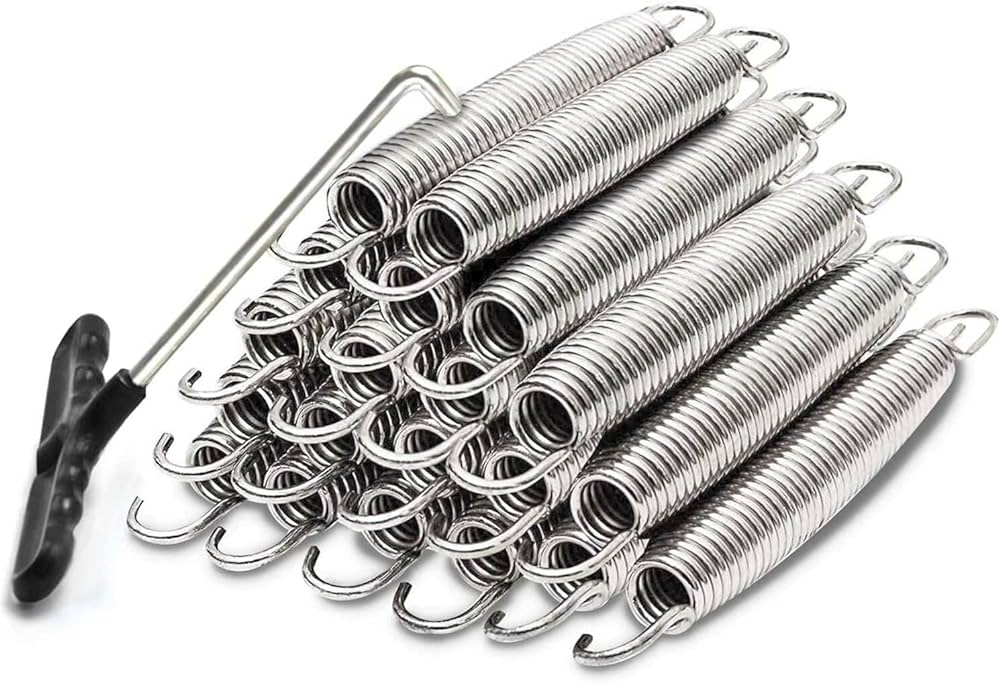Trampoline spring tools can be swapped with pliers or a T-hook for spring replacement. DIY solutions like a pull strap or a strong piece of cloth are also viable alternatives.
Trampolines are a backyard staple, offering fun and fitness for all ages. Ensuring safety and optimal performance means regular maintenance, including the daunting task of replacing springs. It’s a process that requires strength and the right tools. The official trampoline spring tool aids in pulling and securing springs, yet when it’s not available, homeowners might feel stuck.
Fear not, alternatives like locking pliers, a T-hook, or even homemade solutions can step in to assist with this task. These tools, although not designed specifically for the job, enable the user to maintain the necessary tension when hooking trampoline springs into place. Their effective use can prevent the frustration and potential injury that might occur when dealing with this high-tension component of trampoline maintenance.
The Need For Trampoline Maintenance
Keeping a trampoline in tip-top shape is essential. Proper maintenance ensures jumps stay high and safe. Over time, trampolines face wear and tear, especially in the springs. Regular checks and replacements keep fun times going strong. Let’s explore how caring for springs is a big part of this upkeep.
Safety Concerns With Worn Springs
Worn or damaged springs pose risks. They can lead to uneven bouncing surfaces. This can cause falls or injuries. It’s crucial to examine springs often. Look for signs like rust or overstretching. Replacing springs can prevent accidents.
- Check springs for rust or damage regularly.
- Ensure consistent tension across all springs.
- Replace any springs that show signs of wear.
Impact Of Maintenance On Trampoline Lifespan
Regular maintenance can extend a trampoline’s life. Springs are the backbone of any trampoline. They ensure a good bounce and support the structure. By replacing old springs with new ones, you help the trampoline to last longer.
| Maintenance Task | Outcome |
|---|---|
| Clean surface and check springs | Better performance and safety |
| Replace worn-out springs | Longer trampoline lifespan |
Remember that keeping springs in good shape means safer jumps for everyone.

Credit: www.ebay.ca
Trampoline Spring Tool Basics
Jumping on a trampoline provides endless fun and exercise. But to keep the bounces safe and snappy, the springs must stay in top shape. That’s where a trampoline spring tool comes in handy. It’s a must-have for trampoline owners, making the installation and removal of trampoline springs easy. Let’s bounce into the essentials of this nifty gadget.
Function Of The Spring Tool
The spring tool is a simple device with a major purpose. It latches onto the hook of a trampoline spring and leverages tension, allowing you to stretch the spring into place or remove it without a struggle.
- Ensures safety: Keeps your hands away from the tension zone.
- Improves efficiency: Saves time and energy during assembly and maintenance.
- Prevents damage: Protects the trampoline mat from tears caused by incorrect spring placement.
Limitations Of Standard Spring Tools
While essential, not all spring tools are created equal. A standard spring tool may have drawbacks.
- One-size-fits-all issue: May not work well with all spring sizes, risking improper use.
- Durability concerns: Some tools may bend or break under excessive tension.
- Handle discomfort: Can cause hand fatigue if not ergonomically designed.
Finding the best fit for your trampoline spring replacement or maintenance can be a game-changer. Explore alternatives that match your specific trampoline model and personal comfort preferences.
Diy Alternatives For Trampoline Spring Tools
So you’ve got a trampoline with saggy or broken springs. You need to fix it. But wait, you don’t have a spring tool? No worries! Crafty DIY methods are here to save the day. In this guide, we’ll show you how to create homemade tools that are both simple and effective for spring replacement. Let’s dive into some smart, wallet-friendly fixes!
Homemade Pulling Devices
Build your own spring puller with items from your garage. You’ll be surprised by how easily you can make one. Start with a sturdy piece of metal. It could be an old coat hanger or a piece of steel rod. Bend it into a handle on one end and a hook on the other. This will grip your springs perfectly as you pull them into place.
Using Regular Pliers
If building a device isn’t for you, pliers can work too. Just clamp the spring and pull it towards the frame. It might take more elbow grease, but the job will get done.
Leveraging Screwdrivers
A large screwdriver can act as a lever. Slip it through the spring’s end, then rotate and push. The spring should slide over the trampoline hook like magic. This trick is especially good for stubborn springs.

Credit: www.amazon.com
Step By Step: Trampoline Spring Replacement
Step by Step: Trampoline Spring Replacement is essential knowledge for trampoline owners. Springs can wear out or break, impacting the safety and bounce quality of your trampoline. Dealing with broken springs? Follow this guide to refresh your trampoline’s bounce.
Preparing The Trampoline
Proper preparation is key to a smooth spring replacement process. Ensure safety first.
- Clear the area around the trampoline.
- Wear gloves to protect your hands.
- Check all replacement springs for consistency in size and tension.
Removing Old Springs
Removing old springs is straightforward with the right technique.
- Attach the spring pulling tool to the spring hook.
- Pull gently and unhook the spring from the frame.
- Work in a star pattern around the trampoline to maintain balance.
Installing New Springs
Installing new springs correctly ensures a safe and fun jumping experience.
- Hook one end of the new spring onto the jumping mat.
- Use the spring tool to pull and hook the other end to the frame.
- Again, follow a star pattern for even tension distribution.
- Perform a final check to ensure all springs are securely attached.
Remember to double-check the structure for loose or misaligned springs. Replacing springs can bring your trampoline back to life, providing endless fun and exercise.
Safety Tips During Spring Replacement
Replacing trampoline springs can be risky if not done carefully. It is crucial to prioritize safety to prevent injuries. Follow these safety tips to ensure a secure and injury-free spring replacement process.
Proper Tool Handling
Using the right tool correctly is key to safety. Improper use can cause the tool to slip, potentially leading to injuries.
- Choose the right tool. Trampoline spring tools help avoid injury.
- Keep a firm grip. Ensure your hands are dry.
- Stay focused. Distractions increase the risk of accidents.
Ensuring Secure Spring Attachment
Securely attaching springs prevents them from becoming hazardous projectiles.
- Check hook alignment. Ensure hooks face the right way.
- Test each spring. Apply weight gently to test the hold.
- Confirm V-ring security. Springs should firmly connect to the mat’s V-rings.
Troubleshooting Common Trampoline Spring Issues
Trampolines bring endless fun, but the springs can face issues. Knowing how to deal with common spring problems helps keep the bounce in action. From rusted springs to managing tension, you can fix these issues easily. Let’s look at the solutions.
Dealing With Rusted Springs
Rusted springs lose elasticity and can break. Here’s how to tackle rust:
- Inspect springs regularly for rust signs.
- Remove light rust with steel wool or sandpaper.
- Apply a rust-inhibitor spray to protect them.
- Replace heavily rusted springs immediately.
Managing Uneven Tension
Uneven tension affects the trampoline’s bounce. Balance it with these steps:
- Check the trampoline is level on the ground.
- Ensure all springs are hooked properly.
- Adjust springs to equalize tension.
Preventing Spring Overstretching
Overstretching can ruin springs. Prevent it by:
- Following the weight limit of your trampoline.
- Using a spring tool for correct installation.
- Storing it during harsh weather.

Credit: www.ebay.com
Frequently Asked Questions Of Trampoline Spring Tool Alternatives And Spring Replacement
What Is A Trampoline Spring Tool?
A trampoline spring tool is a device designed to simplify the process of attaching or removing springs when setting up or repairing a trampoline. It provides leverage, making it easier and safer to handle the trampoline’s high-tension springs.
How Can You Replace Trampoline Springs Safely?
To replace trampoline springs safely, ensure the trampoline is stable and use a spring tool or alternative tool for leverage. Carefully detach the old spring and hook the new one in place, maintaining balance and control to prevent injuries.
Can You Use Household Items As Spring Tools?
Yes, certain household items like pliers or a T-hook can work as makeshift spring tools. However, they might not offer the same leverage or safety, so it’s advised to employ the right tool for the job when available.
When Should Trampoline Springs Be Replaced?
Trampoline springs should be replaced when they show signs of wear, such as stretching, rusting, or when they lose their elasticity. Regular checks help maintain trampoline safety and performance.
Conclusion
Maintaining your trampoline with the right tools ensures safety and longevity. Exploring alternatives to spring tools and knowing when to replace springs can save time and prevent injury. Embrace these maintenance tips for endless, worry-free bouncing. Keep your trampoline in top shape and let the good times roll!


